
In this article, we are going to take a look at various types of propane lines that can be used for different applications on a propane system installation. There are several different types; all have their own niche, as well as pros and cons.
Copper Pipe
Probably the most used and most versatile is copper. Today, we mainly use coated copper, which has a tough, typically yellow plastic, coating around it. The plastic coating “jacket” serves two purposes. First, it helps protect against corrosion and discoloration from the elements. Second, it helps protect the copper from abrasions. For example, if you were to run uncoated copper through a concrete or brick wall, you would have to run it through a conduit, so the copper line doesn’t rub and possibly wear a cut through the line. With coated copper, you can run the line right through the wall.
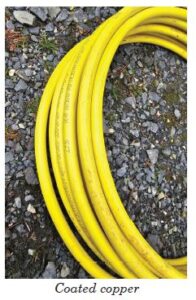
Overall, copper is the preferred material for propane installations. It can be used indoors or outdoors, above ground or buried. It will not rust in the elements like iron. It is also pliable and therefore can be bent and curved into position (within reason). One drawback, however, is that copper does not carry as much flow/pressure as some other materials.
For example, if you look at ½ inch copper and ½ inch black iron, there is a noticeable difference in size. Copper is measured by outside diameter, while iron pipe is measured by inside diameter. Copper’s smaller inside diameter carries less volume of gas downstream to the unit. Due to this, copper can be used on smaller units, such as propane fireplaces and cook stoves, at low pressure. We do, however, use copper in two-stage systems on the high-pressure side, such as 10PSI, before we get to the second-stage regulator and reduce the pressure. Copper is a great multi-use material, with its main downside being the lesser volume of flow it can carry.
Iron Pipe
Iron pipe generally comes in three types: black iron, galvanized and stainless steel. All are the same size and diameter, just with different finishes.
Unlike copper, black iron can carry much more volume. Generally, black iron is located after the second stage regulator on the low-pressure side and is used to carry a greater volume of gas. You will often see black iron or stainless steel coming off a pool heater or a generator where the British Thermal Units (BTUs) of these units are so high that a bigger line is needed to feed the necessary gas volume. It is also used in many other applications, such as coming off a furnace and other large BTU units.
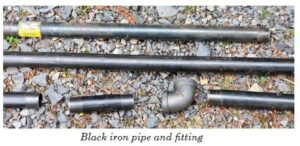
Like copper, iron pipe has drawbacks, as well. For example, black iron rusts quickly when used outdoors. It can be painted to help mitigate any rust issues. Also, black iron cannot be directly buried in the ground. Therefore, many companies will use stainless-steel pipe in outdoor applications instead.
A quick side note on iron piping: If gas vapor is passing through it, Schedule 40 pipe is what is used. However, if liquid propane is going through it, Schedule 80 pipe must be used.
CSST Piping
Now let’s look at a “relatively” new material—corrugated stainless steel tubing (CSST); this material has become quite popular over the last few years. Like most piping, it has its pros and cons.
The pros: it too is measured by inside diameter, so it does not carry quite the flow that iron piping does; however, it carries more than copper lines do. It is also flexible; where iron pipe may not work because it is too rigid to snake through certain areas, CSST can work. Also, when the product first came out, it was against code to directly bury it. However, TracPipe® has come out with a CSST that is specifically designed for direct burial.
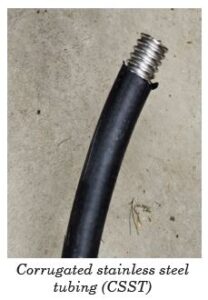
The cons: CSST, like the others, has drawbacks. The walls of the steel, although flexible, are thin.
When this material was first introduced, it was susceptible to lightning strike puncture. Companies such as TracPipe® have attempted to counteract this with a new version called Counter Strike®, which according to the company, reduces the potential for lighting-related damage. We currently use this, but our local codes still require us to bond the line back to the panel box in the customer’s house.
Polyethylene Pipe: “Poly”
This type of line coins the phrase “Do one thing and do it well.” There is only one application where this type of line can be used—it must be outdoors and buried in the ground. It is not UV-rated and therefore can only be used underground. Where the line breaks the surface, special risers are put over the “Poly” itself to connect to the tank or unit. Although this material is easy to work with, there are steps and measures that must be taken during installation. First, we put down sand or screenings on the bottom of the trench, then a bit of screenings/sand on top. Tracer wire is run along the entire length of the poly. This is because the material is plastic and not metal, and if someone had to dig, a metal detector would not be able to detect the line. Several additional inches of dirt go on top and we then run caution tape along the length of the line; we then fill the rest of the trench with dirt. The idea behind the caution tape is that, if someone was to dig, they would hit the tape first before hitting the line. Poly is a very good line that carries high volume for long distances, but must only be used in this exact application.
When using poly, keep in mind there are two different sizings, which are unique with poly, known as IPS and CTS. IPS is measured by inside diameter, which is larger. CTS is measured by outside diameter like copper tubing.
Summary
We use all the materials (line sets) mentioned here on a regular basis. They are all useful and have a role to play in propane installation. It is imperative to know and become familiar with all types of line sets in order to maximize the efficiency of a propane installation while maintaining the highest safety standards. As always, be sure to follow all local and NFPA58 and NFPA54 codes and guidelines on installations. ICM

The second part of this two-part series will discuss larger propane tanks, generally 250 gallon and greater, both above-ground and underground.
Like the previous article on smaller tanks, larger tanks come with their own set of codes that need to be followed. In last month’s article, we looked at propane tanks of 125 water gallon or smaller. It is worth noting again that 125 gallon tanks are the largest size allowed to be right near a building or house.
The first difference (and probably one of the most important) is that all tanks with a water gallon capacity over 125 must now be a minimum of 10′ from a house or building. The code states that it must be 10′ from the nearest liquid withdrawal, not to the steel. Therefore, the steel of the tank could be fewer than 10′ away. However, I can say that in the field, generally we try to keep the tank 10′ away to any area of the tank.
Above ground tanks
Tank sizes up to 500 gallon (generally 250 gallon and 500 gallon tanks) must not only be 10′ from the building, they must also be 10′ away from the property line. This means that if you install a 500 gallon tank only 5′ from your neighbor’s property line, it is out of code.
As with all tanks, they cannot be installed within 10′ of combustible materials, they must be 10′ from source of ignition and 25′ from open flame.
With 1,000 gallon tanks it gets a bit more complicated. A 1,000 gallon tank can be installed both 10′ away from a building, as well as the property line, but only if there are no other propane tanks of more than 125 gallon capacity within 25′ of the 1,000 gallon tank. If there is, then the number gets pushed to 25′ from the building and property line. Confusing?
Let’s break it down. Here’s an example: If I install just one 1,000 gallon tank for a warehouse, that would only need to be 10′ away from the building/property line. However, if the warehouse needs two 1,000 gallon tanks and they are tied together in the same location, the distance from the building/property line must then be 25 feet.
Another example: if the warehouse is huge, one 1,000 gallon tank can go on the right side and another 1,000 gallon tank can go on the left side. Since the two tanks are now more than 25′ from each other, they now could be 10′ from the building/property line.
Transporting
As noted in last month’s issue, propane tanks 125 gallon or fewer can be transported at full capacity, as long as you are placarded to carry over 1,001 lbs. or over (gas and steel combined).
Tanks of 250 gallon or more can only be transported at 5% or less capacity, per DOT standard. The only exception is when removing a tank from a customer’s house. If unable to remove the fuel, you can transport the tank over the 5% capacity, as long as you have the special paperwork required and go right to your bulkplant yard to drop it off.
Underground Tanks
Generally, most of the same rules apply with underground tanks as they do with above-ground tanks.
Any underground tank of 2,000 gallon or fewer must be 10′ from a building and property line, as well as 10′ from a source of ignition.
Installing an underground tank comes with its own set of challenges and there are codes and steps to follow that will ensure the safety and longevity of the tank.
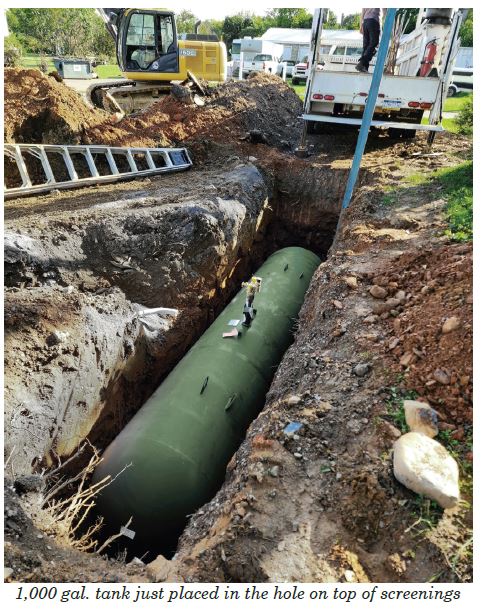
When installing an underground tank, after the hole is dug, a layer of screenings is put down on the bottom to place the tank on. Screenings can be tiny, thin pieces of stone or sand, for example. Once a tank is set down, the sides, and even the top, is filled in with more screenings. The purpose of the screenings/sand is twofold. First, it allows for better water drainage. If enough water pools around the tank and has nowhere to go, there is a possibility that the tank can float up to the surface. That has happened, believe it or not. Second, the screenings/sand around the tank protect it from rocks and debris while being back-filled in.
When putting a metal tank into the ground, moisture and corrosion (which equals rust) can happen. We counteract this problem by placing anode bags in the hole near the tank, which get buried, as well. The anode bags come attached with a wire. That wire goes back to the tank, where it gets attached to a nut on the stem of the tank. This anode helps/prevents corrosion and electrolysis. The anode bags become the sacrificial piece and rot, rather than the tank.
For underground tanks up to 500 gallon, one anode bag is usually used, placed at the center of one side. For tanks that are larger, two anode bags are used. Typically they would be placed cater-cornered on opposite sides of the tank. Both wires would lead back to the tank and be tied in. It is important to wet the anode bags prior to covering them with dirt. This will speed up the charging process of the magnesium. Please note that an anode test needs to be conducted every three years after installation. If the test fails, a new anode bag must be installed.
As with any propane tanks, whether large or small, above- ground or in-ground, following codes and guidelines are essential for proper function and safety. Always follow local codes/guidelines, as well as the Federal codes outlined in NFPA58. ICM

Here is an example of how important it is to be in tune with what you are doing. If something doesn’t look or feel right, trust yourself and check it out. I went to a customer’s house to fill their 1,000 gallon underground tank. This was my first visit there. I flipped open the lid and immediately smelled gas (which should never be the case). I got my leak detector spray and sprayed all the fittings where the copper line comes in to the lid and is connected to the regulator. I saw no bubbles or signs of a leak initially, which was suprising due the overwhelming smell of gas.
So, I took my bottle and dumped quite a bit of liquid all over the top of the stem of the tank and soaked the whole area. Almost instantly, I saw the problem. As shown in the picture, the junction where the top brass section that screws onto the threads at the top of the stem, was leaking.
To fix this, we first had to drain/empty the tank completely so there would not be any pressure in the tank. We then dug down around the dome lid, pulled it off and had to twist off the whole head section on the tank. We cleaned up the threads and made sure they were in good condition. Then we re-pipe doped the threads and screwed the piece back on tightly with pipe wrenches. We re-purged the tank and added methanol back into the tank (methanol is used to keep moisture out of the tank). After that was complete, we then introduced some liquid propane back into the tank and sprayed again to check for leaks. Once we saw that there weren’t any leaks, we then filled the tank back to capacity.
This is just a helpful reminder to use your senses to make sure the propane system is safe and operating correctly.
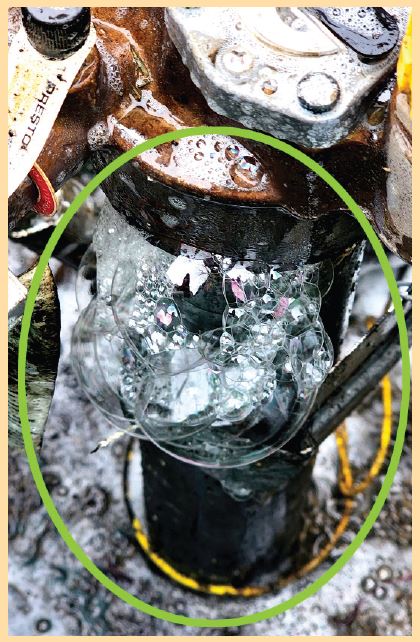

In this two-part series, we are going to discuss propane tank locations as outlined in the Federal guidelines of NFPA 58. For the purpose of this article, we will break this into two categories. The first will be about propane tanks with a capacity of 120 gallons or fewer, which is the largest size allowed up against a house or building. The second will concern 250 gallons tanks and larger that have different codes and requirements that need to be followed.
It shall be also noted that although the NFPA 58 is the national guideline for tank locations, all local codes must be adhered to as well. The general rule of thumb is to follow the code that is more strict, whether that be the NFPA codes or local codes.
To begin, we need to identify two different types of cylinders. All 20lb, 30lb, 40lb, fork-lift tanks, many of the 100lb and even the older 200lb and 120 gallon tanks are considered Department of Transportation (DOT) cylinders because they can be transported on the road and the DOT is the governing body for these tanks. DOT tanks need to be recertified (also known as requalification) 12 years from the date of manufacture and periodically thereafter by a trained recertification professional. There are different re-certification methods that determine how long until the tanks need to be re-certified again. This will be covered in a future article.
American Society of Mechanical Engineers (ASME) tanks do not require recertification after installation. They are good in the field for their lifetime. ASME tanks would only be taken out of service if an issue arose.
Tank locations
20lb, 30lb and 40lb tanks are the typical tanks found on a grill or camper and typically not used on a house due to their small capacity. Liquid propane weighs 4.2 lbs/gallons, a 20lb full tank holds approximately 4.76 gallons. Some of the larger tanks found alongside a house are 100lb, 200lb, 300lb.
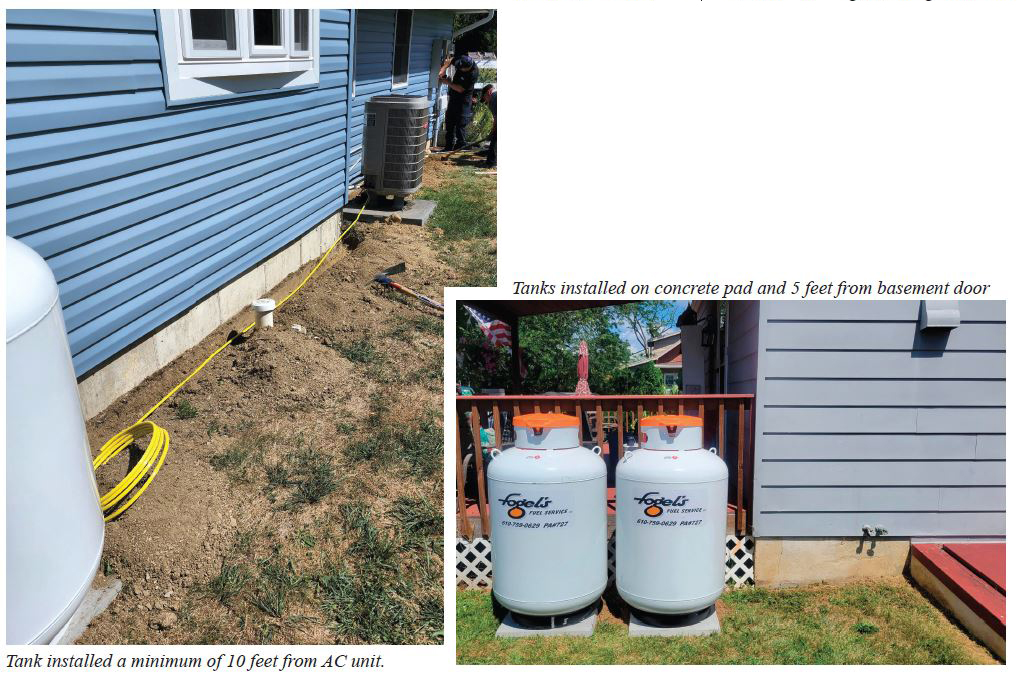
Both DOT and ASME tanks that are filled on-site need to be a minimum of 10 feet from any external/direct source of ignition. This includes air conditioning units, generators, window air conditioners and even direct vents from heating system or fireplaces. Using a measuring tape in a horizontal line to measure the space between the liquid withdrawal or fill valve (whichever is closer) to the source of the ignition—this must be a minimum of 10 feet. The only exception is if the tank is not to be filled on-site; it can then be five feet away. Most tanks are filled on-site with a bobtail truck. However, if the customer has a smaller tank and unhooks the tank to get it filled somewhere else, it can then be 5 feet from the ignition source.
A DOT tank must be 3 feet from a door or a window (measuring horizontally) if the door/window is below the liquid relief/fill valve. This is because propane is heavier than air, and while filling the tank or if there is a leak, propane will always sink and could possibly seep into the building.
For ASME tanks, the same rules apply, except the minimum distance is five feet. It is best to avoid placing tanks directly under powerlines going to the house. Tanks should always be set on either a concrete pad or concrete blocks for two reasons—stability and air flow, which helps the tank dry, reducing the possibility of rust. A tank must not be set on any type of wood, which could rot or break and risk the tank falling over.
Tanks should never be placed in an enclosed space. An enclosed area like a shed can get extremely hot and does not have ventilation. If the relief valve opens due to increased internal pressure or fails, or if the tank develops a leak, the propane gas will get trapped in a tight environment with nowhere to escape causing an explosion and fire hazard. Also, do not place a tank within 10 feet of stored or accumulated combustible material.
ASME 120 and DOT 420 (fewer than 125 gallons) tanks may be installed under a deck providing there is a minimum of a 50% open perimeter, however adding lattice or similar structures may have different requirements Always refer to and follow NFPA 58 codes as well as local codes prior to tank installations.
Part 2 will look at tanks 250 gallons and greater. ICM

•ICM: Thank your for your time today, first let me ask you who is PERC and what is its mission?
•Perkins: PERC stands for the Propane Education & Research Council and it’s mission is to support the users of propane and make sure that the fuel is used safely; to develop the most modern technologies; and to make sure that our industry and the marketers that service, install and respond to customers are well-trained.
As the U.S. grapples with the issues of climate, health and justice, we are trying to make sure that our propane offerings are not only environmentally and technically sound, but still provide comfort and heat while meeting the climate and health needs of today.
•ICM: Most of the Northeastern States and the federal government have aggressive goals to reduce carbon output, some by as much as 40% by 2030 and possibly 80% by 2050. A key element of this is eliminating combustion in buildings by converting homes to electric-powered heat pumps. Is this a threat to propane?
•Perkins: We don’t want to view it as a threat to propane. Clearly, if they were to eliminate fossil fuels, natural gas and propane would be included. For some reason, we have allowed this to become a war of “Electrification vs. Fossil Fuels” when, in fact, it’s a war on carbon and unfavorable climate change. We are prepared to enter the conversation about reducing carbon using clean, low-carbon fuels such as propane and natural gas. We live in a world where 3-second sound bites are how we understand information, rather than talking about complex issues. I don’t worry about the threat to propane nearly as much as I worry about that. This conversation is moving us to a place where consumers may not be warm, may not have hot water or may not have the choice of how they want to cook.
The propane industry is completely aligned with a war on carbon, but the methods—such as replacing combustion with electric heat pumps—make me insane. That’s not the battle or the conversation we should be having; it should be Can propane/gas furnaces still lead to increased climate benefit and health? The answer is, Surely, they can.
•ICM: Most descriptions of propane and natural gas fall under the “fossil fuel” category, which is considered a higher carbon fuel. Can you expound on how propane is a low-carbon fuel?
•Perkins: Let me start by giving you a visualization. Today, a propane vehicle operating in 38 States would be cleaner than an electric vehicle. There’s this view that electricity is clean energy and propane or natural gas, or any other carbon fuel, is not. In fact, propane offers the most efficient, modern water heating possible. In most States, heating water with propane is more efficient and beneficial to the environment than heating water with electricity. In the Northeast, vast quantities of fossil fuels are used to generate electricity, so how is the environment better off by making electricity from coal, oil and wood? The average citizen has been completely misled or has missed those points.
•ICM: Taking the side of the public policy makers here in the Northeast, their plan for beneficial electrification, or decarbonization, is focused on electricity generated by renewable resources. Any response to that?
•Perkins: Absolutely. I salute the fact that the electric grid of tomorrow will be cleaner than the electric grid of today. If we are going to make any improvements in climate and health, it will have to be. I don’t for one moment pretend to believe that the massive steps toward a decarbonized grid—80% solar and wind—is going to happen. If you look across the world that’s not happened, and where it’s happened, there have been tragic consequences, mainly around reliability and cost.
However, clearly the U.S. electric grid is going to improve—we’re going to get rid of coal, replace natural gas, use more renewable sources. The grid is going to shift because of technical innovation, batteries, solar panels, thermal efficiencies, etc. However, for some reason, people don’t realize that low-carbon fuels, such as propane and natural gas, are making those same technical innovations, and I might argue at the same pace or even better.
•ICM: Your position is that propane, which is generally lumped in with fossil fuels and does have carbon emissions, is still a better choice than electrification. This is because the generation of electricity is from higher carbon sources and is an indirect transmission to the end-user suffering efficiency losses along the way?
•Perkins: Absolutely. When we look at these technologies, we have to look at them from the full economic cycle—the time it takes to make, transport, store, use and then dispose of it. If you look at it in a scientifically honest way, low-carbon fuels have a wonderful place at the table. Also, you’ll never hear me talk about climate without talking about health; climate tends to be about the health of the Earth. Health is about living things—humans, plants and animals—and it’s about things like NOx emissions and particulate matter.
Then there is justice. I refuse to believe that changing electric prices by a factor of two or three is good for everyone. I think in the climate, health and justice lens of today, low-carbon fuels have a role to play, and not just as a bridge fuel, but as a fuel for the foreseeable future. I believe that in 2030, 2040 and 2050, batteries will be different than they are today. Solar and wind will probably be different in 2050 as well, but with absolute certainty, gas/propane furnaces, water heaters and gas stoves will be materially different in 2050.
•ICM: You’ve mentioned that propane is a low-carbon fuel—is that universally accepted from the scientific, environmental or the public policy sectors?
•Perkins: You have to look at people’s motivation. I try to look at this from all levels—scientific, climate and public policy. I find that so much of this is hyped-up because people are trying to convey a specific point of view. If you step back for a second and think about decarbonization, when we have so much consumption of diesel fuel, gasoline and coal, using lower-carbon fuels has an immediate impact on carbon reduction. We want a world that exists with reliable power, heat, hot water and a place to cook our meals; I don’t prescribe to know what will happen past 2050, but until then, I don’t know that we’re going to build much more hydro-power, which is quite clean in terms of carbon. There has been talk of small-scale nuclear, but I believe nuclear is on its way out, along with coal. How are we going to replace those vast producers of clean energy without using more propane or natural gas?
•ICM: Does PERC do any lobbying or public relations? How do you get your version of the story across? Because certainly, here in the Northeast where ICM is located, the story from public policy makers is somewhat different than what your story is.
•Perkins: The story from the public policy people is that the best way to clean up the climate is to install heat pumps. I don’t know how many engineering degrees they have, but certainly heat pumps have a wonderful coefficient of performance at 60°F, but I wonder if they’ve talked to people who actually used even the most modern heat pumps at -25°F. Have they even studied the coefficient of performance at those low temperatures or thought about the real impact on comfort, health and on the electric grid when the coefficient of performance is no longer three or higher, but dropped far below one? Propane would be much more beneficial, not only for comfort and cost, but also for the environment.
Let me get back to your question of “Does PERC lobby?” We are exclusively prohibited from lobbying, so when I talk to you about solutions and public policy, we look at solutions in a very clinical way. What does the scientific data lead us to believe about decarbonization? What does it lead us to believe about impacts on health and justice? We really leave public policy to others once we have presented a clear view of the science and benefits. We do try to inform not only those who sell propane, but also those who use propane about its features and benefits and why it is a wise choice. We do tend to advocate for using propane in the situations where it makes sense. We’re trying to get to a healthier climate and to healthier people in a way that is intellectually honest.
•ICM: Is the industry working on an alternative drop-in fuel that would have a lower carbon score than propane as we know it today?
•Perkins: Yes, the carbon-intensive propane of today is around 79. By the way, the U.S. grid today, because it’s still intensely driven by coal and natural gas, is almost twice the carbon intensity of propane. However, as we think about our world in 2030, 2040 and 2050, we know we must drive down the carbon intensity of propane.
The first arrow in the industry’s quiver was renewable propane, which is making propane from fats and oils. This can have a carbon intensity in the high teens, but generally, depending on the feedstock, that carbon intensity is around 20. Therefore, give or take, we’ve already cut our carbon intensity by 75%.
However, I don’t believe that’s good enough. Then we began thinking about dimethyl ether (DME) and then renewable DME with an ultralow carbon intensity. I tend to believe the fuels of tomorrow won’t be just propane, but could be any combination of those four fuels—propane, DME, renewable propane renewable DME. I haven’t yet talked about the things we’re working on in various labs across the country—propane as a transporter of hydrogen and propane with carbon capture. Another thing we’re working on is a plasma technology to capture methane, which is itself a greenhouse gas. There would be great benefits to the climate if we could capture unburned methane and convert it straight to propane. The future is very bright around renewable fuels.
•ICM: How close are renewable propane, DME and renewable DME to being market-ready? Would they be market-ready as a plug-in fuel?
•Perkins: We’re running renewable propane in probably four or five States, generally in the transportation market and in material handling. We are also testing blends of propane, renewable propane, DME and renewable DME in different applications. Our goal is, as you correctly say, always to have a drop-in fuel, be able to deliver it in the same vessels and store in the same tanks that we use today. We know how to use DME and renewable DME directly, but they’re not really drop-ins yet for propane appliances and propane engines. Everything we’re working on are blends that are drop-in ready. Renewable propane is ready today and renewable DME should be ready to use within 12 months. In the future, there could very well be blends specific to the application; we could actually have the builder mix a blend of propane and renewable propane for residential or commercial construction. We may get to the point where there would be a cocktail that could be blended by State, by use or even by end-user need.
•ICM: Many ICM readers are retail propane distributors, mostly for residential heating and hot water, who are also retail heating oil delivery retail marketers. The oil heating industry has already started introducing blends of alternative ultralow carbon fuels such as biodiesel. Recently, the transition has become more aggressive. One of the biggest issues they are facing is the convincing of public policy makers, particularly here in the Northeast, that these low-carbon fuel mixes are much better for carbon reduction than electrification, which is what you’re saying as well. Do you see any synergy here between the two industries, or any possible cooperation?
•Perkins: I think there has to be an improved, cooperative, working relationship between the oil, propane and natural gas industries. I always commend oil dealers, because I think they saw this coming and began working on decarbonization long before other industries. The one thing that’s nice about oil and propane is that we’ve always known how to work together with other fuels. We’ve never really been the “gorilla on the block” like natural gas.
The homeowner of the future will probably have solar roof tiles or solar panels, might have a wind turbine and certainly a battery, and I think both the oil industry and the propane industry are well accustomed to being a part of the solution in multi-fueled homes.
•ICM: Do you see the introduction of lower carbon versions of propane as an area for possible market growth?
•Perkins: Between efficiency improvements and renewable fuels, there is a grand future. However, one area where I find the conversations have been misleading is in regard to buildings; there is this overarching thought that removing fuels and moving into electricity will be beneficial. It’s obvious that all we’d be doing is trading a reliance on fuels. In the U.S., we’ve at least learned how to become completely self-dependent on our own fuels. Are we now going to trade that for a reliance on minerals, batteries, etc.? Are we trading our own self sufficiency for a tremendous reliance on China?
Also, think about the full economic cycle of minerals and mining, as well as battery use, storage and disposal. What are the improved benefits to the Earth’s climate? You see a lot of smart scientists now beginning to question this move towards electrification—is it truly benefiting the climate?
I think if we just keep our eye on the prize, which is reducing carbon, that low carbon fuels will have a big seat at the table.
PERC’s operations and activities are funded by an assessment levied on each gallon of propane gas at the point it is odorized or imported into the United States. More about PERC at propane.com. ICM